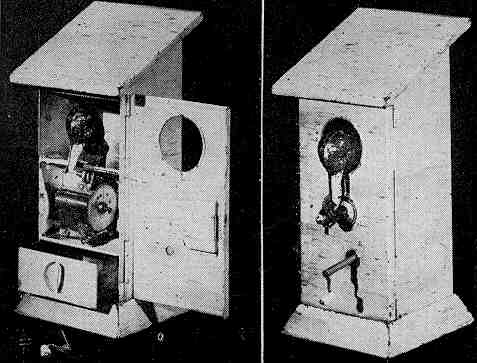Woodpecker Bank
by F.H. Griffith - HOBBIES Magazine - April, 1957

A bank whose appearance and size are more or less unattractive but whose mechanism and operation are of particular interest is our choice as No. 54 in our numerical classification of mechanical banks. This bank, the Woodpecker Bank, is rather large in size since it is 12 inches high and appearance-wise it is inclined to look rather box-like. Actually the bank represents a bird house made of birch bark and its proportions are about the same as those of an actual bird house, hence its rather large size as compared to the other mechanical banks.
To the best of the writer’s knowledge there is, as yet, no known factual background concerning the Woodpecker Bank. From some angles it has indications of a foreign manufacture, possibly Germany. The music box, shown in the picture, is obviously Swiss, however, this is of no help in ascertaining the origin of the bank. It may have been made in England or France, or possibly the United States. There are no markings of any kind that would help to identify it. There is a number stamped in the underside of the base. The banks were apparently numbered in sequence as a specimen belonging to another collector has a different number on the underside.
The bank was obtained by the writer through the good help of Mrs. Rose Arnold of Chicago, Ill. It had been in her family for some 50 years and had originally been given to her brother by a family friend. As Mrs. Arnold recalls the bank was not new when given to her brother and to the best of her memory it was some 10 to 15 years old at the time. This would establish the bank as being made during the period of the 1890’s. Unfortunately Mrs. Arnold had no other information as to where the bank originated or any other pertinent facts. It is of interest to note that Mrs. Arnold informed the writer that they had always called the bank the Crow Bank.
Two pictures of the bank are shown, one with the mechanism exposed, as the working parts are unusual and quite different than any of the other mechanical banks. To operate the bank a coin is placed on the end of the perch as shown in the one picture. At this point the bird’s head cannot be seen as it is inside of the bank. The operator then turns the crank clockwise and the music box starts playing a tune. As the operator continues to turn the crank the bird’s head very slowly emerges from the opening accompanied by the music. The bird then grasps the coin in its beak as shown in the picture. Then the bird very deliberately taps the coin on the perch three times, after the third tap the bird snaps back into the house with a bank dropping the coin inside the bank. The coin drops through a tapered slot into the coin drawer. This drawer is shown partially open in the picture showing the inside of the bank. The music plays during the entire operation and stops right after the woodpecker pops inside the bank with the coin.
The bank is not particularly colorful as the entire outside of the bird house is painted to resemble birch bark. The back part of the door is painted the same way and the inside of the house is cream color. The bird head is black and brown with a yellow beak and the eyes are realistic glass eyes. The perch is painted brown.
The entire structure of the bank is made of a rather heavy sheet iron type of material. This is reinforced around the roof and base by heavy wire inserted in the rolled over edges. The gears and works of the bank are made of brass as is the head of the bird. The head is a finely made two-part stamping. The entire front of the house is hinged like a door and this locks in place with the key shown. Even the crank is original, and this is nickel plated with a porcelain knob.
Perhaps an explanation is in order on the writer’s part concerning the Woodpecker Bank. There had existed a certain amount of uncertainty as to whether or not the bank was a commercially produced item to be sold to the trade and thus an authentic mechanical bank. The two known existing specimens, found some 20 odd years ago, were not available for inspection. This was the case until last year when the third known Woodpecker Bank turned up in Philadelphia, and right after this the writer was fortunate enough to obtain his specimen. It’s rather unusual, but to the best of the writer’s knowledge, there were no specimens of this bank found during the above mentioned 20 odd year period. In any event, there is no question in the writer’s mind, after thorough inspection, that the Woodpecker Bank was a commercially produced item and thus an authentic mechanical bank. Let us hope that at some future date information will turn up establishing the actual origin of this interesting bank.
